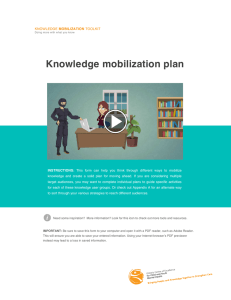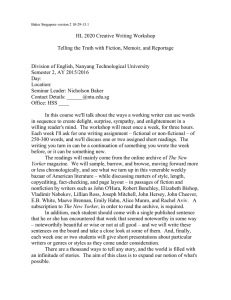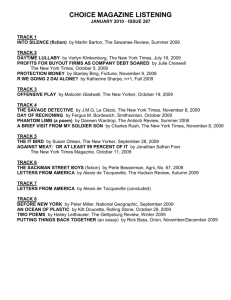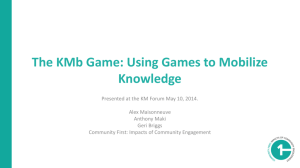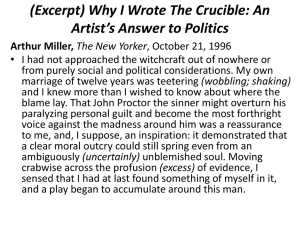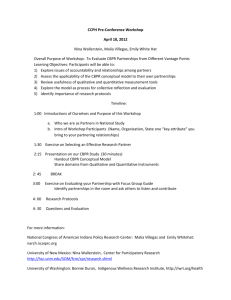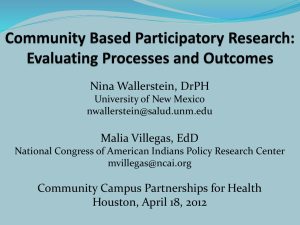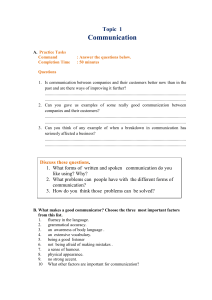Workshop_Peter_Levesque_NICEnet_2010
advertisement
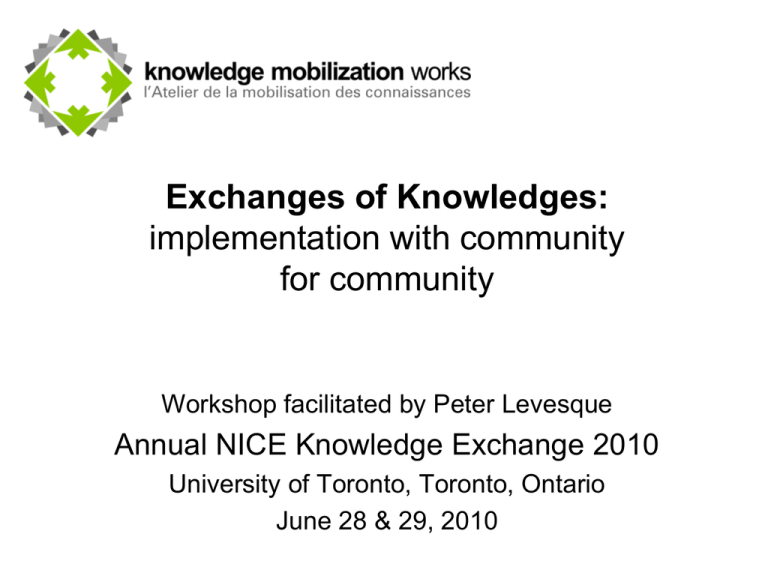
Exchanges of Knowledges: implementation with community for community Workshop facilitated by Peter Levesque Annual NICE Knowledge Exchange 2010 University of Toronto, Toronto, Ontario June 28 & 29, 2010 Agenda Introductions Part 1: community based participatory research Part 2: fundamentals of knowledge exchange and mobilization Part 3: conversations and their component parts Part 4: managing the value chain Part 5: ethics and empathy as equal partners with logic and technique Summary and discussion www.knowledgemobilization.net 2 Introductions In 10 Seconds: Example: 1. Your Name 1. Peter Levesque 2. Your Organization 2. Knowledge Mobilization Works 3. Your Position 3. Director www.knowledgemobilization.net 3 Part 1: Community based participatory research • • • • • • • • Definition(s) Community Social Action Community Building Community Assessment Understanding Coalitions Using the Arts Internet www.knowledgemobilization.net 4 Definition(s) • Community based participatory research • Community-based participatory research (CBPR) is a collaborative approach to research that combines methods of inquiry with community capacity-building strategies to bridge the gap between knowledge produced through research and what is practiced in communities to improve health. Interest is growing rapidly for academic institutions, health agencies, and communities to form research partnerships; few agreed-upon guidelines describe how to develop or evaluate CBPR proposals or what resources are required to promote successful collaborative research efforts. • http://ahrq.gov/downloads/pub/evidence/pdf/cbpr/cbpr.pdf Roots in 3 fields: – Popular education – International development – Shop floor democracy • Also known as: – – – – – Participatory action research Community-university research Action research Community organizing Asset based community development www.knowledgemobilization.net 5 Community • Community is typically seen in geographic terms • Can be based on shared interests or characteristics (ethnicity, sexual orientation, occupation) [Fellin 2001] Community defined as: 1. Functional spatial units that meet basic needs for sustenance 2. Units of patterned social interaction 3. Symbolic units of collective identity [Hunter 1975] 4. People coming together to act politically and make changes [Eng and Parker 1994] www.knowledgemobilization.net 6 Social Action • Classic social action is grassroots based, conflict oriented, with a focus on direct action, and geared to organizing the disadvantaged or aggrieved to take action on their own behalf [Fisher 2005] www.knowledgemobilization.net 7 Community Building • Community building practice seeks to engage multiple dimensions of community, recognizing the range of perspectives and relationships that exist and integrating diverse strategies and methods of practice. [Walter 2005] www.knowledgemobilization.net 8 Community Assessment • Why do community assessment? – Measure, describe and understand community lifestyles – Assess community resources to lessen external dependency – Return needs assessment data to facilitate decisionmaking – Provide skill training, leadership, and organizational skills – Facilitate collective activities and group mobilization – Enable consciousness raising • Information for change has 3 purposes: – To stimulate change or action – To monitor change or action – To assess the impact of change or action www.knowledgemobilization.net 9 Understanding Coalitions • Coalitions, partnerships, and consortia are popular strategies for dealing with complex health and social issues - they are hard work [Wandersman, Goodman, Butterfoss, 2005] • Inter-organizational, cooperative, synergistic alliances - from latin: to grow together/union Benefits of coalition • New and broader issues • Demonstrate wide support • Maximize power of individuals and organizations • Minimize duplication of efforts and services • Mobilize talent, resources, and influence • Recruit from diverse constituencies • Exploit new resources as conditions change www.knowledgemobilization.net 10 Using the Arts • Literature, music, video, painting, photography and other forms of artistic expression are powerful tools for community organizing [McDonald 1998] • Taps into visceral forms of knowing and reacting to the world and carries a great deal of meaning [Riley 2001] www.knowledgemobilization.net 11 Internet • Has expanded access to information - but not for every project or community effort. • Best Uses: – – – – Assessing opposition Assessing the news coverage Conducting policy research Community building • E.G.:Community Tool Box http://ctb.ku.edu – Assessing public health issues – Assessing the political context – Assessing allies www.knowledgemobilization.net 12 Part 2: Fundamentals of knowledge exchange and mobilization • • • • • Definition(s) Modes Professional Revolution Goal History lesson a la New Yorker www.knowledgemobilization.net 13 Definition(s) • Knowledge Mobilization – is the complex process of making what we know ready for service or action to build value. – Getting the right information to the right people in the right format at the right time to influence decision-making – Never in human history have we hunted for so much data, information and knowledge. – Never in human history have we gathered so much that is useful but not used. – Growing feeling of being “overfed” with information? www.knowledgemobilization.net 14 Modes of KMb www.knowledgemobilization.net 15 Professional Revolution • Knowledge Management • Knowledge Transfer • Knowledge Exchange • Knowledge Mobilization • Knowledge Translation • Evidence-based practice • Evidence-based decision-making • Evidence-informed policy • Evidence-informed practice www.knowledgemobilization.net 16 But what is the goal? To do the best for those we care about www.knowledgemobilization.net 17 Publish or Perish New Yorker: Mischa Richter 1966 www.knowledgemobilization.net 18 Plain language New Yorker: Dana Fradon 1975 www.knowledgemobilization.net 19 Use of evidence New Yorker: Mick Stevens 1989 www.knowledgemobilization.net 20 Impact New Yorker: Sam Gross 1991 www.knowledgemobilization.net 21 Access New Yorker: John Caldwell 2000 www.knowledgemobilization.net 22 Part 3: Conversations and their component parts • Definition • Core considerations • Relationships of all content sources • Dissemination • Accessibility • Diversity www.knowledgemobilization.net 23 Core KMb Considerations Context Conversations Capacity Culture Content www.knowledgemobilization.net Conversations 24 Content: Relationships between all sources Philip Davies, Is Evidence-Based Government Possible? Jerry Lee Lecture 2004, Washington, DC www.knowledgemobilization.net 25 KMb practice to avoid! www.knowledgemobilization.net 26 26 Dissemination • Scattering of seeds • Spread widely – How do we prepare the soil to receive the seeds? – How do we nurture the growth of these seeds? – What does the harvest look like? – What happens in the marketplace? www.knowledgemobilization.net 27 KMb practice to avoid! www.knowledgemobilization.net 28 28 Accessibility • Access – Physical • Increasing access to findings published in Journals, on-line, open access, systematic reviews – Conceptual • What does this mean for my practice, location, context, culture www.knowledgemobilization.net 29 KMb practice to avoid! www.knowledgemobilization.net 30 30 Systems need Diversity • The challenge with herding cats is that the cats may have interests that are non-standard. • How to support BOTH the utilization of standards and the exploration of the new? • Managing for diversity provides the potential to learn and create resilience. www.knowledgemobilization.net 31 Part 4: Managing the value chain • Definition • Traumatic information? • What is research knowledge? • Think of a value chain? • Exchange • Networks www.knowledgemobilization.net 32 Value Chain • The value chain, also known as value chain analysis, is a concept from business management that was first described and popularized by Michael Porter in his 1985 bestseller, Competitive Advantage: Creating and Sustaining Superior Performance. • The sequential set of primary and support activities that an enterprise performs to turn inputs into value-added outputs for its external customers. • Hybrid Value Chain www.knowledgemobilization.net 33 Richard Heinberg Taking in traumatic information and transmuting it into lifeaffirming action may turn out to be the most advanced and meaningful spiritual practice of our time. http://globalpublicmedia.com/how_do_you_like_the_collapse_so_far www.knowledgemobilization.net 34 …what is Research Knowledge? – Hierarchy of Knowledge, Dave Sackett: • Systematic reviews/ meta-analyses • RCTs • Experimental designs • Cohort control studies • Case-control studies • Consensus conference • Expert opinion • Observational study • Other types of study eg. Interview based, local audit • Quasi-experimental, qualitative design • Personal communication www.knowledgemobilization.net 35 Thinking of a Value Chain Programs Policies Priorities Processes Practice Innovation Supporting Infrastructure Initiatives Value Creation Now What: Decisions, Directions, Actions So What: Meaning, Analysis, Interpretation Products Perspectives Procedures Possibilities People Skills Incentives to Share between Levels What: Data, Information, Description, Stories MULTIPLE INPUTS FROM RESEARCH, PRACTICE, EXPERIENCE, CULTURE 36 Exchange www.knowledgemobilization.net 37 Network Images: Collaboration of Physicists http://www-personal.umich.edu/~mejn/networks/collab.gif www.knowledgemobilization.net 38 Network Images: Characters from Les Misérables http://www-personal.umich.edu/~mejn/networks/lesmis.gif www.knowledgemobilization.net 39 Networks www.knowledgemobilization.net 40 Part 5 - brief: Ethics and empathy as equal partners with logic and technique www.knowledgemobilization.net 41 Summary & Discussion – Community engaged research is fundamentally about mobilizing knowledge – Knowledge comes in multiple forms: scientific, traditional, experiential, explicit, tacit – Working “with” is very different from working “on” or “for”. – When working with any vulnerable population consider the person within their network. – There are many layers to the work, they are interconnected and emergent – The internet is a great tool for access and assessment but limited. – Value is always created from exchange – Whole systems are more than the sum of parts. www.knowledgemobilization.net 42 4x4 Exercise - time permitting • • • • Find a discussion partner 5 minutes for each conversation Produce key words or short phrase from each conversation (2 minutes) Move to next conversation with a different partner Questions 1. What has been your key experience from working with community on research? 2. What are the core skills needed? 3. How do you think about networks? 4. What will you do next to improve your ability to engage with community? www.knowledgemobilization.net 43 Questions & Comments www.knowledgemobilization.net 44 Contact Information www.knowledgemobilization.net 45
